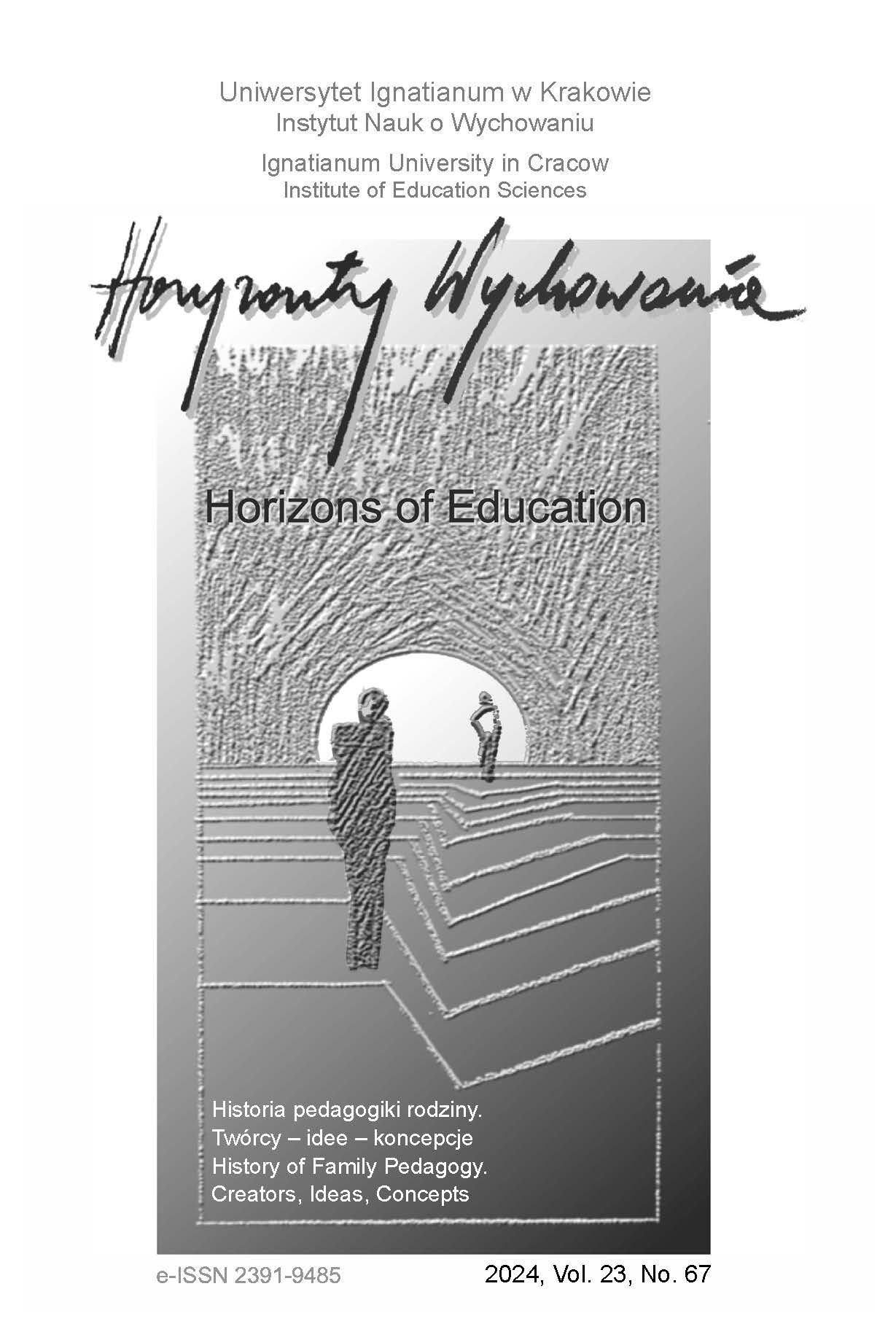Artistic Education in Jerzy Vetulani’s Perspective: A Comparative Analysis With Irena Wojnar’s Polish Concept of Aesthetic Education
Abstrakt
CEL NAUKOWY: Celem artykułu jest prezentacja założeń antropologicznych, estetycznych i pedagogicznych postulatu kształcenia artystycznego oraz porównanie go z koncepcją wychowania estetycznego Ireny Wojnar.
PROBLEM I METODY BADAWCZE: Pytania problemowe sformułowano następująco: Jakie są założenia antropologiczne, estetyczne i pedagogiczne postulatu kształcenia artystycznego J. Vetulaniego? Czy występuje podobieństwo między postulatem kształcenia artystycznego J. Vetulaniego a propozycją wychowania przez sztukę I. Wojnar? Do realizacji celu naukowego wykorzystano metodę analizy treści w modelu Karoliny Szczepaniak.
PROCES WYWODU: Na podstawie poglądów neurobiologicznych J. Vetulaniego najpierw sztuka została ukazana jako cecha wyróżniająca homo sapiens, a następnie jako czynnik najpełniej aktywizujący ludzki mózg, zwłaszcza jego funkcje poznawcze. W tej perspektywie omówiono założenia pedagogiczne postulatu Vetulaniego. Następnie porównano koncepcję Vetulaniego i Wojnar pod kątem założeń antropologicznych oraz znaczenia sztuki w procesie wychowania człowieka.
WYNIKI ANALIZY NAUKOWEJ: Według Vetulaniego związek człowieka ze sztuką jest uwarunkowany biologicznie. Sztuka jest czynnikiem koniecznym, aby osiągnąć pełnię człowieczeństwa. Zarówno Vetulani, jak I. Wojnar traktują człowieka jako istotę z natury otwartą na sztukę, która pełni funkcję antropotwórczą w procesie wychowania.
WNIOSKI, REKOMENDACJE I APLIKACYJNE ZNACZENIE WPŁYWU BADAŃ: Sztuka odgrywa istotną rolę w procesie kształcenia człowieka w poglądach Vetulaniego i Wojnar. Technika obrazowania mózgu może wzbogacić tradycyjne wychowanie estetyczne. Wyakcentowana przez Vetulaniego aktywizacja funkcji poznawczych mózgu dzięki sztuce, zwłaszcza uwagi poznawczej, może być wykorzystana w leczeniu powszechnych zaburzeń koncentracji dzieci i młodzieży.
Bibliografia
Eco, U. (Ed.). (2005). Historia piękna [History of beauty] (A. Kuciak, trans.). Dom Wydawniczy Rebis.
Gerber, N., & Myers-Coffman, K. (2018). Translation in arts-based research. In P. Leavy (Ed.), Handbook of arts-based research (pp. 572–586). The Guilford Press.
Gołaszewska, M. (1986). Zarys estetyki: Problematyka, metody, teorie [Outline of aesthetics: Issues, methods, theories] (3rd ed.). Państwowe Wydawnictwo Naukowe.
Leavy, P. (Ed.) (2018). Handbook of arts-based research. The Guilford Press.
Nęcka, E., Orzechowski, J., Szymura, B., & Wichary, S. (2020). Psychologia poznawcza [Cognitive psychology] (2nd ed.). Wydawnictwo Naukowe PWN.
Read, H. (1976). Wychowanie przez sztukę [Education through art] (A. Trojanowska-Kaczmarska, Trans.). Zakład Narodowy Imienia Ossolińskich – Wydawnictwo Polskiej Akademii Nauk.
Szczepaniak, K. (2012). Zastosowanie analizy treści w badaniach artykułów prasowych – refleksje metodologiczne [The application of content analysis in research on newspaper articles: Methodological reflections]. Acta Universitatis Lodziensis Folia Sociologica, 42, 83–112.
Wojnar, I. (1966). Perspektywy wychowawcze sztuki [Educational perspectives of art]. Nasza Księgarnia.
Wojnar, I. (1970). Estetyka i wychowanie [Aesthetics and education]. Państwowe Wydawnictwo Naukowe.
Tatarkiewicz, W. (1985). Historia estetyki. T. 1 [History of aesthetics. Vol. 1]. Wydawnictwo Arkady.
Vetulani, J. (2010). Mózg: fascynacje, problemy, tajemnice [The brain: Fascinations, problems, mysteries]. Wydawnictwo Homini.
Vetulani, J. (2011). The brain and art. In J. Posłuszna (Ed.), Psychology of art and creativity (pp. 51– 54). Wydawnictwo Aureus.
Vetulani, J., & Mazurek, M. (2015). Bez ograniczeń. Jak rządzi nami mózg [No limits: How the brain rules us]. Wydawnictwo Naukowe PWN.
Vetulani, J., Mazurek, M., & Wierzchowski, M. (2017). Sen Alicji, czyli jak działa mózg [Alicja’s dream, or how the brain works]. Wydawnictwo WAM.
Encyklopedia PWN. (2004). Ewolucja. In B. Kaczorowski (Ed.), Nowa Encyklopedia Powszechna PWN [New PWN Universal Encyclopedia] (p. 15). Wydawnictwo Naukowe PWN.
Copyright (c) 2024 Horyzonty Wychowania

Utwór dostępny jest na licencji Creative Commons Uznanie autorstwa – Bez utworów zależnych 4.0 Międzynarodowe.
Uwagi dotyczące praw autorskich
Autorzy publikujący w tym czasopiśmie wyrażają zgodę na następując warunki:
- Autorzy zachowują prawa autorskie, przyznając czasopismu prawo do pierwszej publikacji swojego tekstu jednocześnie zarejestrowanego pod numerem licencji CC BY-ND, która pozwala innym na korzystanie z tego tekstu z uznaniem autorstwa tekstu oraz pierwotnej publikacji w tym czasopiśmie.
- Autorzy proszeni są o nawiązywanie odrębnych, dodatkowych porozumień wynikających z umowy, dotyczących dystrybucji opublikowanej w czasopiśmie wersji tekstu nie na prawach wyłączności (np. opublikowanie go w repozytorium instytucji lub w innym czasopiśmie), z potwierdzeniem pierwszej publikacji w tym czasopiśmie.
Wyraża się zgodę i zachęca autorów do publikacji ich tekstu w Internecie (np. w repozytorium instytucji lub na jej stronie internetowej) przed lub podczas procesu składania tekstu jako, że może to prowadzić do korzystnych wymian oraz wcześniejszego i większego cytowania opublikowanego tekstu (Patrz The Effect of Open Access). Zalecamy wykorzystanie dowolnego portalu stowarzyszeń badawczych z niżej wymienionych:





